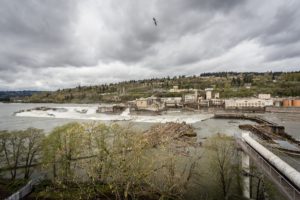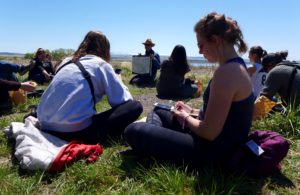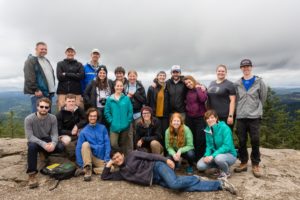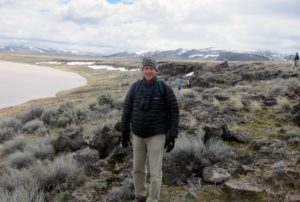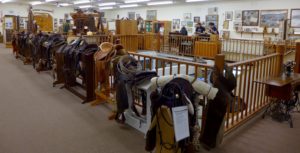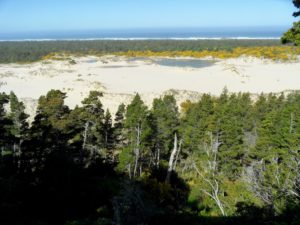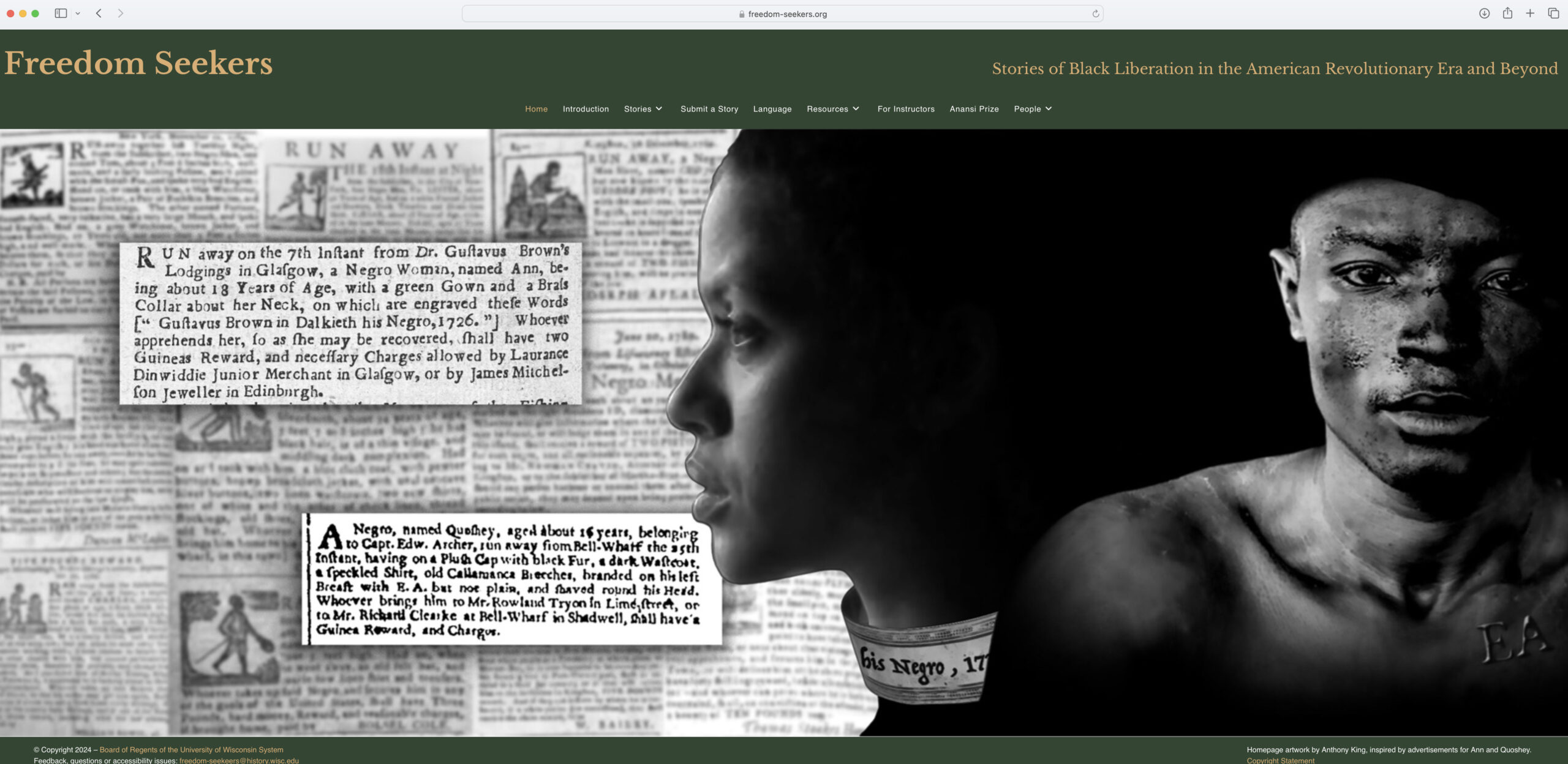Be rather the Mungo Park, the Lewis and Clark and Frobisher, of your own streams and oceans; explore your own higher latitudes. … Be a Columbus to whole new continents and worlds within you, opening new channels . . . of thought … It is not the while to go round the world to count the cats in Zanzibar.
—Henry David Thoreau, Walden (1854)
I used these words from Thoreau as a sort of descriptive come-on to promote an integrated set of courses I taught at the University of Oregon last spring (2017) with colleagues in biology and earth sciences, Bitty Roy and Josh Roering. We called the all-inclusive program “Oregon Abroad.” The plan, which had produced wonderful results previously, was to offer four interrelated courses (a student’s full schedule for the ten-week term) to fully immerse students in the study of Oregon’s natural and cultural history. By employing the classroom, laboratory, archive, and field study, these courses in history, field biology, environmental geology, and environmental studies were to provide a unique, comprehensive educational experience, in a way comparable to study abroad—except that the “abroad” here was close to home. Instead of going “round the world to count the cats in Zanzibar,” as Thoreau recommended against, we’d consider the pinnipeds beyond Portland, track the southward movement of Oregon Falls, examine the native wildflowers of our wetlands and sample sagebrush galls in the high desert, calculate Coast Range mountain debris flows, and determine if Lewis and Clark are the most overrated heroes in American history. We’d ask, why did many consider the Willamette Valley a paradise at the end of the Oregon Trail? And why and how did those pioneers (and their descendants) seek to “improve” it? We’d study why Oregon looks like Oregon, how it’s changed, and how that landscape is and was a product of nature and culture.
The explorers and colonizers Frobisher and Mungo Park are not exactly household names, though many students in Oregon know of the intrepid duo Lewis and Clark and have heard of the more antique Columbus. Lewis and Clark’s expedition represents the critical narrative moment at which Oregon history becomes American history. That would be a hook for us in the course, as would the loosely formed suspicion a few might have had that these two, along with Columbus, Frobisher, and Park, might carry some colonial baggage. I feared that the students didn’t know but were afraid to ask, “Who’s Thoreau?” As it turned out, existing knowledge gaps gave us more historical landscape to explore and metaphorically settle without the necessity of clearing lots of mythic underbrush. The educational ground was mostly fertile, not barren.
We enrolled nineteen undergraduates in this interdisciplinary, cross-disciplinary, immersive experiment. Each student took all four upper-division courses (there were no prerequisites), and no non-Oregon Abroad students were permitted to take any individual course, so the nineteen formed a discrete, cohesive group of learners. And that community of learners included us, the instructors, who sat in and participated in each other’s classes, co-taught an Environmental Studies seminar to fully integrate our disciplinary offerings, and together with our students spent one full day a week outside, in the field—in wetlands and upland prairies, dense forests and sagebrush steppe, desert playas and urban ecologies, coastal dunes and mountain ridges. For a week in May we decamped to the Malheur National Wildlife Refuge in eastern Oregon for more intensive field study. Of the nineteen students, the majority were majoring in biology, two in geological sciences, a few in environmental studies and sciences, but only two in history, though some of our students had minors that pulled them into other academic worlds—philosophy, studio arts, education. In past iterations of the course, there has been a more diverse range of majors, which allows us to draw on more varied academic experiences and perspectives, aiding in our mutual education. The underrepresentation of history majors this past spring was not so much a problem as a challenge and opportunity in my teaching—to engage non-historians and fill in some gaps in their knowledge, to prod their curiosity and demonstrate to them that history was more interesting and important than they might have realized.
In the academy we celebrate interdisciplinary work and collaboration in research and teaching. And some of the great questions—and problems—of our world demand such approaches. Global climate change and inequality, for example, come quickly to mind. But historians’ record in rising to this challenge has been mixed—history is the most internally interdisciplinary of the major disciplines, and we’ve seen in history the creative and transformative incorporation of the concepts, tools, and approaches of other disciplines, particularly in the study of early America. But usually, in their scholarship and teaching, historians have worked in a certain solitary confinement.
History is a bookish discipline. Academic historians write books and articles, and to do so we conventionally read other books and articles, and other sorts of writing preserved in documents, the fragile materials best preserved in climate-controlled libraries and archives. In isolated places, historians usually toil alone, building on each other’s work but doing so mostly in solitary ways. We might, generously, call this approach independent. But we live in an increasingly complicated, inter-dependent world—one that we can better address as historians if we get outside occasionally, both literally and figuratively.
In Oregon Abroad, we emphasized new forms of research and writing that challenged the cloistered approach to history—ones that pull historians into the field to examine other kinds of sources, like the varied landscapes that have been shaped by human ideas and action as well as nonhuman forces. And ones that demand specialized knowledge that historians don’t necessarily have, and that require collaboration with others who do. This sort of historical work, drawing on models more common in the sciences, enriches our own ability to understand and interpret the past and infuses other scholarly and applied work with historical analysis that might otherwise be lacking.
It was energizing—fun and rewarding—to get outdoors and to work with others to answer some pressing historical questions—in environmental history especially but not exclusively. And it was also exciting to find some new questions out there, which we could then take back indoors to address with the help of the archives.
Lately I’ve been thinking about the early modern phenomenon of natural history, and I’ve become a bit envious of its integration, what we might now call its “interdisciplinarity.” Natural historians in the eighteenth and early nineteenth centuries studied the natural and human world more comprehensively, in less specialized fashion. The early modern natural historian—including not merely the learned but the curious—scrutinized the world broadly. In a sense these laypeople and scholars were “undisciplined,” but in a good way—one that made them at once botanists, ornithologists, zoologists, geologists, paleontologists, archaeologists, even historians. Actually, our students, who take an array of courses in various fields, and who must cultivate breadth even when committed to particular majors, can offer models for how we might approach our complex, hyper-specialized world. If natural history in the early American republic was a widely shared “tool to investigate, to catalog, to explore, and, ultimately to know the new nation,” as the historian Andrew Lewis has argued in A Democracy of Facts: Natural History in the Early Republic (2011), then we might also use it as (to paraphrase Lewis) “a method and means for a new citizenry to take ownership” of our contemporary communities, broadly construed, natural and cultural, global as well as local.
How did we do this in Oregon Abroad?
It took considerable discussion and planning, but we three instructors synchronized our syllabi, blending chronology, themes, and topics to explore the natural and cultural history of Oregon and the Pacific Northwest. The three disciplinary classes were in some ways conventional—with appropriate readings, lectures, labs, papers, presentations—but we bent the courses toward each other to provoke cross-disciplinary questions and intensify learning. And we required students to keep a journal that combined their learning, reflections, and insights from all the courses in one considered place, again drawing on Thoreau as our model. Our approach was cumulative, loosely chronological, reiterative, with frequent variations on the same themes—and far from a linear, one-damn-thing-after-another style of describing and interpreting the past.
We began our teaching with concepts and big questions that have concerned us broadly, whether as humanists, social scientists, scientists, or simply denizens and citizens of the world. Such queries were persistently social and philosophical, scientific and historical. What is “nature,” and how is it related to “culture”? How are both related to the physical world? Does nature have a history? Is history fundamentally humanistic, or can the non-human world—or even the nonorganic world—have “history”? These matters are not easily settled, but laying them out early allowed us to revisit them constantly, and to consider them in various scholastic and material contexts, indoors and out. In the first week students read excerpts from Thoreau; from the Scottish naturalist David Douglas, who travelled in Oregon in the 1820s and for whom the Douglas fir is named; and from Paul Crutzen, the contemporary Nobel Prize-winning atmospheric chemist known for introducing the term anthropocene to highlight our pivot into a new geological epoch corresponding to the unprecedented human impacts on the earth and its climate.
That first week we also spent a day walking the millrace adjacent to the University of Oregon, and exploring its connections to the Willamette River, which runs through campus and the city of Eugene. The city itself dates to the mid-nineteenth century, formally incorporated in 1862, but first emerging in the late 1840s when Eugene Skinner set up a trading post there, along the Willamette River about ninety miles south of Oregon City (the site of Willamette Falls) and Portland (at the river’s junction with the Columbia River).
Eugene occupies the southern edge of the Willamette Valley, where the Willamette River forms and heads north toward the Columbia. The valley was the magical destination of wagon trains on the Oregon Trail. But of course, those pioneers did not settle a people-less place. It was the home of Native Kalapuyans who had lived a rich life there for generations and shaped the landscape in ways that made it seem, ironically, Edenic to early nineteenth-century colonists. They thought it was wild, untransformed nature. It wasn’t—it was someone else’s homeland. We were mindful of this reality throughout Oregon Abroad, and in fact we studied not merely what was there in Oregon, but what was gone, or was missing—the result of willful exclusions in the natural and social ecology that continue to bedevil this relatively un-diverse state.
The millrace we walked in week one had been built in the 1850s, connecting two old sloughs or abandoned riverbeds with each other and the Willamette on each end. The canal became Eugene’s first industrial power source, enabling milling of grain and lumber, other processing of agricultural products, and some manufacturing. Over time, its economic success and purpose changed, as did the course of the river, and the millrace morphed over time as a place of commerce, recreation, aesthetic pleasure, and at times neglect and environmental degradation. For many now the millrace is invisible—a place not noticed or considered, like freeway medians or neglected roadside patches. Walking it gave us plenty to see anew and contemplate, considering the millrace as a historic relic and a riparian space that’s both artificial and natural, teaming with aquatic life, lined with plants, filled with a changing cast of avian visitors, and sometimes burdened with trash and pollution.
Our survey on foot had a practical purpose. The university is expanding and building a new campus in these environs, and the university currently manages the upper millrace. Planners needed to know more about it in order to determine how to incorporate it into the new campus. And its preservation was not a certainty. As part of the class, we required that students develop individual research projects related to the millrace that would inform this information-gathering and planning process. Their project could be historical, biological, geological, or even artistic, or multidisciplinary. Collectively and with some collaboration with each other and the instructors, their research could (and did) make an actual contribution, helping to preserve and guide renovation of a distinctive natural, utilitarian, historical, and potentially aesthetic feature of the campus and the city of Eugene.
In subsequent weeks, as students shaped their millrace projects, we assayed our natural, cultural, and historical landscape more expansively, breaking our study into weekly topics. We devoted a week to water—especially rivers and wetlands—asking some broad questions that we approached from diverse disciplinary perspectives: What is a river? Is it a physical, a natural, a human space? Is it a process, a machine, an organic being? What are the economics, politics, laws and ethics of its manipulation? How do we conserve, preserve, or restore it, and what are the practical implications of each?
Our inquiry was less abstract that it might seem. We grounded our study locally, exploring how Natives and newcomers to Oregon conceived of the region’s rivers differently and used them in contrasting ways. On a vaster historical scale, we learned about their geological creation and the repeated transformation of watersheds via the mechanisms of plate tectonics, volcanism, ice, and shifting climate. A field trip took us to Oregon City, the site of Willamette Falls (the largest waterfall by volume west of Niagara) where geology, biology, and human history converged. The falls have a long and complicated geological history, which is imbricated with a biological history (we focused on migrating salmon and eels and also spied a sea lion at the falls’ base), which is connected to a human history of Native people who gathered there to fish and to trade, and who encountered intrusive colonists, who then found it a congenial spot to raise the first major white settlement in the territory. In turn, these colonists used the power of the water there for manufacturing, transforming the falls into an organic machine, producing energy, including electricity, delivered in revolutionary fashion over wires to Portland, fourteen miles away, in 1889. Now the rusting infrastructure of that process sits largely idle, sublimely postindustrial, defying conventional aesthetics but perhaps poised for renovation—which would entail, paradoxically, environmental restoration, innovation, and historical preservation.
Other weeks adopted the same approach—posing large questions, assessing them specifically, locally, physically, materially, in the realms of geology, biology, landscape studies, anthropology, literature, art, and history. The concept of landscape—as defined by scholars such as J.B. Jackson and John R. Stilgoe—proved particularly useful for blending our disciplinary inquiries into interdisciplinary knowledge. Landscape in this sense is not the physical land in some state unaltered by humans; it is land shaped by human and nonhuman forces into a hybrid space, both “natural” and cultural. The word landscape originated from the old Frisian word landschop—that is, shoveled land. In English by the sixteenth century, it had become landskep and eventually landscape, designating the surface of the earth shaped for human habitation.
Through landscape, we considered colonialism, not only linking settler-colonialism in Oregon to earlier practices in North America farther east, but also addressing environmental alteration, via the Columbian Exchange, the nature and impact of invasive species, and the fate of native plants and animals as well as people. We studied the impact of agriculture, including the introduction of new ways of owning, claiming, dispossessing, and “improving” land, and the impact of new plant regimes—that might feed more people and enhance human life but also have less benign effects, including the impoverishment of soils, waters, and people. We queried: What is a “natural resource”? (Are trees living organisms or proto-lumber?) What is a “forest”? (A surprisingly complex question, with technical answers in biology, history, and the law.) Why do we find the woods, alternatively, scary or picturesque, critical to clear (or to “harvest”) or important to conserve or preserve in reserves or parks? And how are such questions and answers culturally and historically specific? What happens—particularly on steep slopes—when we clear-cut them? (Tragically, in the Pacific Northwest, too often deadly landslides or debris flows.)
How and why are wetlands important—for all sorts of life, human and otherwise, and for their role in shaping the physical landscape itself, especially coastally? When did swamps become wetlands, why and to whom? Are mountains sublime or merely dreadful, and how are they formed, eroded, and rebuilt geologically? What is the role of ice in these places, and does ice have a history, or is it, in the form of glaciers, “history”? Are beaches wastelands, vital ecotones, or recreational spaces; are they beautiful or treacherous? When and how did a day at the beach become “a day at the beach”? What is a desert, and how odd is it that so much of Oregon constitutes desert, or that a good portion of the state resides, not on the Pacific Slope, but in the Great Basin? And how did the recent land rights controversy that erupted in Burns, Oregon, and the Malheur Wildlife Refuge in January 2016 stem from legal, constitutional, and political arrangements that date to the Constitution and to the Northwest land ordinances of the 1780s, when the Northwest meant Ohio?
Malheur, in addition to its deep and fascinating geological history and its biological wonders—including its place on a trans-American flyway accommodating birds travelling thousands of miles between the arctic and South America—served us as a microcosm of American history. It all lay before us, in texts, in local museum displays, and in a landscape of sage brush plains, ponds, rivers, and lakes, glaciated cliffs, volcanic cones and maars, and layers of human inscriptions, some obvious (roads, fences, grading, dikes, and canals), some faint (obsidian tool making sites, ancient petroglyphs). A long, complex Native history featuring environmental adaptation and alteration was disrupted by colonial incursions, beginning in the late eighteenth century, first through the fur trade, then through ranching, homesteading, warfare, and Native dispossession in the nineteenth century. In the twentieth century, the region saw the impact of Progressive Conservationism, Reclamation, New Deal reform, a new environmentalism, and the Sage Brush Rebellion.
In short, our explorations in Oregon Abroad were wide-ranging but deeply grounded in the landscape, the history, and the natural history of, to use Thoreau’s language, our own “higher latitudes.” As it turns out, there’s lots of history in the Pacific Northwest that might be considered part of the early American past. But more importantly, Thoreau’s latitudes exist in lots of other places. And it would be possible to do something similar to Oregon Abroad elsewhere—what locales do not possess interesting and significant geological, biological, and historical pasts (and presents and futures), if we’re willing to look for them? Places and stories vary, but wherever they occur they are no less amenable to integrated, immersive study—even the most urbanized landscapes—and the interdisciplinary mix of courses and instructors at other non-Zanzibar institutions might also vary to include other sciences, social sciences, or humanistic disciplines and the arts.
In my nearly thirty years of teaching, I’ve never had a better teaching experience than Oregon Abroad—professionally, intellectually, or personally. As the term ended, one student bemoaned that soon she’d have to return to “regular college.” Oregon Abroad taught us all to look and see differently, and to ask new questions. What actually lay before us, how did it get this way, and how might it have looked a hundred or a thousand or even a million years ago? We connected texts with contexts in fresh ways, making those contexts more material, topographical, and ecological. We reconsidered chronology and the temporal dimensions of our trade as historians, challenging ourselves to assess geological and evolutionary time scales beyond our normal modes of historical inquiry, and imagining the consequences of future historical, biological, and geological time scales interacting as climate changes. And we considered diversifying our historical sources and ways of knowing—in one case discovering, for example, that before written records in the Pacific Northwest we could nonetheless determine with precision the exact moment of a devastating Cascadia earthquake (with a magnitude of between 8.7 and 9.2), using geological and biological records, as well as distant historical sources. We know it occurred at 9 p.m., January 26, 1700, as exactly as if it had been reported in the New York Times, evidenced generally by the scientific study of the inundation and death of western red cedars near Copalis Beach, Washington, and more precisely by Japanese prefecture records recording the resulting tsunami that travelled thousands of miles across the Pacific and later crashed on Japan’s shores.
As a historian, I was gratified to attune the group to the importance of stories—our stock-in-trade. History is the art and craft of telling stories accountable to the facts as we can know them, and Oregon Abroad students who came without much experience in the discipline found it revelatory to distinguish between the past itself and history. What sort of stories do we tell about ourselves and our place, how true are they to the historical evidence, and how do they matter? In turn, we were able to compare history’s stories (and popular ones that historians critique) with those scientists tell—with science’s empirical and speculative explanations, often historical, that must be consistent with the facts. Our historiographical queries pushed our scientists to think through the meaning and implications, not merely of current scientific consensuses, but also of past ones. Ideally, such attention to stories and the past might not only prove historically illuminating but enhance our contemporary production of scientific knowledge and communication. Oregon Abroad helped make the case that stories matter.
Further Reading
Henry David Thoreau’s classic work is Walden or, Life in the Woods (1854); his writings can be found online. See especially the Walden Woods Project. For the botanist David Douglas’s natural historical chronicle of the early nineteenth-century Oregon Country, see Journal Kept by David Douglas During His Travels in North America 1823-1827 (London, 1914).
On landscape, see John R. Stilgoe, What is Landscape? (Cambridge, Mass., 2015); John R. Stilgoe, Common Landscape of America, 1580-1845 (New Haven, 1982). For a very short introduction to the concept of the anthropocene, see Paul Crutzen, “Geology of Mankind,” Nature 415: 23 (January 3, 2002). And see Richard Monastersky, “The Human Age,” Nature 519 (2015) 144-147, both online at nature.com. For an illuminating and challenging assessment of “wilderness” and the relationship between culture and nature in American culture, see William Cronon, “The Trouble with Wilderness; or, Getting Back to the Wrong Nature,” in Cronon, ed., Uncommon Ground: Toward Reinventing Nature (New York, 1995) 69-90. On the beach as a place and concept see Daniela Blei, “Inventing the Beach: The Unnatural History of a Natural Place,” Smithsonian.com (June 23, 2016).
A brief, thought-provoking, and informative history of the Pacific Northwest’s great river is Richard White, The Organic Machine: The Remaking of the Columbia River (New York, 1995). Joseph E. Taylor III, Making Salmon: An Environmental History of the Northwest Fisheries Crisis (Seattle, 1999) is the best book on this fraught subject. Peter G. Boag, Environment and Experience: Settlement Culture in 19th-Century Oregon (Berkeley, 1992) is an exemplary environmental history of the southern Willamette Valley and its Native and “pioneer” past. William G. Robbins, Landscapes of Promise: The Oregon Story, 1800-1940 (Seattle, 1997) is a comprehensive environmental history of Oregon; its sequel, Landscapes of Conflict: The Oregon Story, 1940-2000 (Seattle, 2004) takes the story through the twentieth century.
Jarold Ramsey, ed., Coyote Was Going There: Indian Literature Of The Oregon Country (Seattle, 1977) is a wonderful collection of narratives, which helps give voice to the resilient Native people of the region. Charles Wilkerson, The People Are Dancing Again: The History of the Siletz Tribe of Western Oregon (Seattle, 2010) is a recent exemplary historical and contemporary study of a Native people and their place. Useful general resources are Jeff Zicker, Kay Hummel & Bob Høgfoss, eds., Oregon Indians: Culture, History & Current Affairs, an Atlas & Introduction (Portland, 1983) and the Oregon Historical Society’s Oregon History Project.
Nancy Langston, Where Land & Water Meet: A Western Landscape Transformed (Seattle, 2003) is the definitive environmental history of the Malheur basin. Larry Pynn, “Written in Wood: The Western Red Cedars of Cascadia,” in Last Stand: A Journey through North America’s Vanishing Rainforests (Corvallis, Ore., 2000): 29-42, tells the story of the 1700 Cascadia earthquake as written on the landscape. William Cronon, “A Place of Stories: Nature, History, and Narrative,” Journal of American History 78 (March 1992): 1347-76, helps us understand the nature of story-telling about the past.
This article originally appeared in issue 18.2 (Spring, 2018).
Matthew Dennis is professor emeritus of history and environmental studies at the University of Oregon and the author of Cultivating a Landscape of Peace: Iroquois-European Encounters in 17th-Century America (1993); Red, White, and Blue Letter Days: An American Calendar (2002); Riot and Revelry in Early America (co-editor, 2002); Encyclopedia of Holidays and Celebrations, 3 vols. (editor, 2006); and Seneca Possessed: Indians, Witchcraft, and Power in the Early American Republic (2010); his current book project is American Relics and the Politics of Public Memory.




